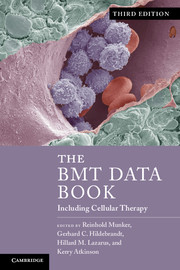Book contents
- Frontmatter
- Contents
- List of contributors
- Foreword
- Preface
- Acknowledgments
- Section 1 Basic science
- Section 2 Hematologic malignancies
- Section 3 Solid tumors
- Section 4 Nonmalignant disorders
- 15 Therapeutic decision making in BMT/SCT for severe aplastic anemia
- 16 Therapeutic decision making in BMT/SCT for congenital immunodeficiencies
- 17 Therapeutic decision making in BMT/SCT for hemoglobinopathies
- 18 HSCT for inborn errors of metabolism and neurodegenerative disorders
- 19 Therapeutic decision making in BMT/SCT for autoimmune disorders
- Section 5 Cellular therapy
- Section 6 Practical aspects and procedures
- Section 7 Complications
- Section 8 The BMT/SCT pharmacopoeia
- Section 9 HLA-testing and laboratory medicine
- Appendix Guide to the internet and literature databases relevant for BMT/SCT
- Index
- References
18 - HSCT for inborn errors of metabolism and neurodegenerative disorders
Published online by Cambridge University Press: 05 August 2013
- Frontmatter
- Contents
- List of contributors
- Foreword
- Preface
- Acknowledgments
- Section 1 Basic science
- Section 2 Hematologic malignancies
- Section 3 Solid tumors
- Section 4 Nonmalignant disorders
- 15 Therapeutic decision making in BMT/SCT for severe aplastic anemia
- 16 Therapeutic decision making in BMT/SCT for congenital immunodeficiencies
- 17 Therapeutic decision making in BMT/SCT for hemoglobinopathies
- 18 HSCT for inborn errors of metabolism and neurodegenerative disorders
- 19 Therapeutic decision making in BMT/SCT for autoimmune disorders
- Section 5 Cellular therapy
- Section 6 Practical aspects and procedures
- Section 7 Complications
- Section 8 The BMT/SCT pharmacopoeia
- Section 9 HLA-testing and laboratory medicine
- Appendix Guide to the internet and literature databases relevant for BMT/SCT
- Index
- References
Summary
Basic principles and rationale for allogeneic HSCT in inborn errorsof metabolism (IEM)
The IEM are a group of genetic disorders in which a multisystem progressive disorder arises from enzyme deficiency and accumulation of products of metabolism within the cells and tissues. After successful engraftment following HSCT, the donor cells not only reconstitute the lymphohematopoietic system but also, more slowly, replace tissue macrophages such as Kupfer cells in the liver and microglial cells in the CNS of the host. In most IEM, the beneficial effect of HSCT on disease outcome is mediated by a process called cross correction. This was first shown in vitro, over three decades ago, in fibroblast cell cultures of Hurler syndrome (MPSIH) and Hunter syndrome (MPSII) patients (Neufeld, 1983). In HSCT, the enzyme produced and secreted by the engrafted donor cells is taken up by the enzyme-deficient host cells, leading to the correction of the underlying disease phenotype in the patient (Krivit, 1983).
The first allogeneic HSCT for MPSIH was performed in the U.K. in 1981 (Hobbs et al., 1981). To date, over two thousand HSCTs have been carried out for metabolic disorders, mostly in MPSIH patients. Other metabolic disorders treated with HSCT include MPSII, Maroteaux Lamy syndrome (MPSVI), Sly syndrome (MPSVII), α-mannosidosis, and X-linked adrenoleukodystrophy (X-ALD). In a successful allogeneic HSCT in IEM, the enzyme delivered by the donor cells should be adequate to prevent substrate accumulation within a given disease and stop or reverse the disease progression. However, in certain lysosomal storage diseases (LSDs) such as San Filippo disease (MPSIII), normalization of enzyme levels is not sufficient to halt the disease progression (Sivakumur & Wraith, 1999). This reflects the complex pathogenesis and the difficulty in treating this group of illnesses. The reason for apparent HSCT failure in some IEMs remains unclear. Another important consideration of HSCT efficacy in these disorders is the selective response in some organs after HSCT (Masterson et al., 1996), particularly if the transplant is performed late after the diagnosis or in the presence of advanced disease.
- Type
- Chapter
- Information
- The BMT Data BookIncluding Cellular Therapy, pp. 192 - 204Publisher: Cambridge University PressPrint publication year: 2013



